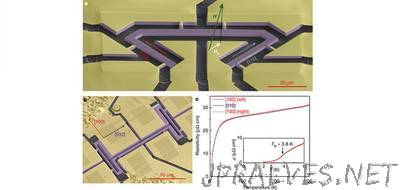
“New research published this week shows a rare state of matter in which electrons in a superconducting crystal organize collectively. The findings lay the groundwork for answering one of the most compelling questions in physics: How do correlated electron systems work, and are they related to one another? The paper, Electronic in-plane symmetry breaking at field-tuned quantum criticality in CeRhIn5, was published in the journal Nature. Electrons in most metals act individually, free to move through a metal to conduct electric currents and heat. But in a special sample of layered cerium, rhodium and indium (CeRhIn5), scientists discovered that electrons unite to flow in the same direction (a behavior called “breaking symmetry”) when in high magnetic fields of 30 tesla. Known as “electronic nematic,” this is a rare state of matter between liquid and crystal. “It’s sort of like in ancient times,” clarified Philip Moll, principal investigator of this work and leader of the Physics of Microstructured Quantum Matter Group at the Max Planck Institute for Chemical Physics of Solids in Germany. “People would draw maps in whatever direction best served them. But this state is like the moment when the world’s mapmakers unified to arbitrarily pick north as the orientation for all maps.” Scientists believe that the electronic nematicity state may be closely related to superconductivity, another strongly correlated electron state in which electrons flow with no resistance. This cerium crystal becomes a superconductor under high pressure. But when placed in a high magnetic field, it demonstrates this electronic nematic state. Because it exhibits both behaviors, CeRhIn5 appears uniquely positioned to one day reveal possible interactions between these two correlated electron phases. “This fundamental question in materials in which the electrons interact was the starting point for my PhD thesis,” said Maja Bachmann, a doctoral student on the research team. “Do the electrons have to decide either to pair or to all go in one direction? In other words, are superconductivity and nematicity competitive phenomena, or could the same interaction that leads to pairing also create nematicity?” This research featured a specialized sample fabricated from a single crystal of CeRhIn5 using focused ion beam (FIB) machining, and required experiments in both pulsed and resistive magnets. Work in the DC Field Facility’s 45-tesla hybrid magnet showed that the nematic phase appears in very high fields, beginning at 30 teslas and remaining through the hybrid’s full field. Researchers wanted to understand how far this phase extended and, through experiments at the Pulsed Field Facility, found that, at around 50 teslas, the nematicity vanishes, possibly even undergoing another exotic phase transition.”
